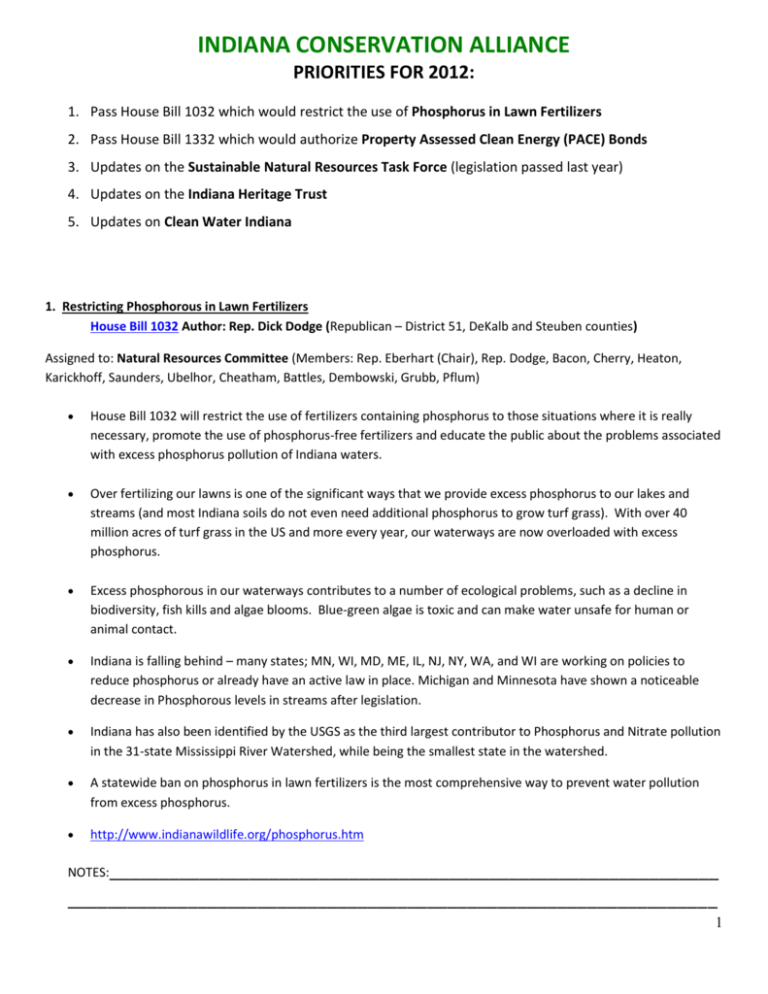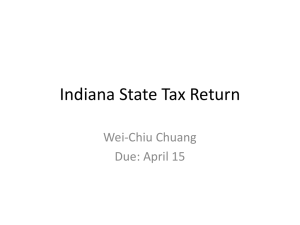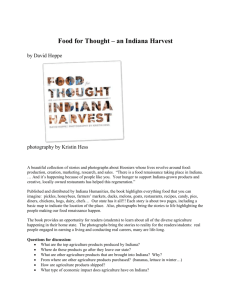Indiana Heritage Trust (IHT)
advertisement

INDIANA CONSERVATION ALLIANCE PRIORITIES FOR 2012: 1. Pass House Bill 1032 which would restrict the use of Phosphorus in Lawn Fertilizers 2. Pass House Bill 1332 which would authorize Property Assessed Clean Energy (PACE) Bonds 3. Updates on the Sustainable Natural Resources Task Force (legislation passed last year) 4. Updates on the Indiana Heritage Trust 5. Updates on Clean Water Indiana 1. Restricting Phosphorous in Lawn Fertilizers House Bill 1032 Author: Rep. Dick Dodge (Republican – District 51, DeKalb and Steuben counties) Assigned to: Natural Resources Committee (Members: Rep. Eberhart (Chair), Rep. Dodge, Bacon, Cherry, Heaton, Karickhoff, Saunders, Ubelhor, Cheatham, Battles, Dembowski, Grubb, Pflum) House Bill 1032 will restrict the use of fertilizers containing phosphorus to those situations where it is really necessary, promote the use of phosphorus-free fertilizers and educate the public about the problems associated with excess phosphorus pollution of Indiana waters. Over fertilizing our lawns is one of the significant ways that we provide excess phosphorus to our lakes and streams (and most Indiana soils do not even need additional phosphorus to grow turf grass). With over 40 million acres of turf grass in the US and more every year, our waterways are now overloaded with excess phosphorus. Excess phosphorous in our waterways contributes to a number of ecological problems, such as a decline in biodiversity, fish kills and algae blooms. Blue-green algae is toxic and can make water unsafe for human or animal contact. Indiana is falling behind – many states; MN, WI, MD, ME, IL, NJ, NY, WA, and WI are working on policies to reduce phosphorus or already have an active law in place. Michigan and Minnesota have shown a noticeable decrease in Phosphorous levels in streams after legislation. Indiana has also been identified by the USGS as the third largest contributor to Phosphorus and Nitrate pollution in the 31-state Mississippi River Watershed, while being the smallest state in the watershed. A statewide ban on phosphorus in lawn fertilizers is the most comprehensive way to prevent water pollution from excess phosphorus. http://www.indianawildlife.org/phosphorus.htm NOTES:_____________________________________________________________ _________________________________________________________________ 1 2. Authorization of Property Assessed Clean Energy Bonds House Bill 1332 - Wes Culver (R-Goshen), Tim Neese (R-Elkhart) and Mary Ann Sullivan (D-Indianapolis), assigned to Environmental Affairs. The major obstacle for property owners to invest in energy efficiency improvements and renewable energy systems is the lack of upfront capital. This bill addresses this problem by authorizing cities and counties to issue dedicated bonds that provide the upfront capital for property owners who willingly and voluntarily seek to make those clean energy purchases. As a result, property owners begin instantly saving money on their energy bills. Property owners pay back these assessments as line items on their property tax bills (though they do not fall under the property tax caps.) The other major obstacle for clean energy investments is that property owners hold their properties for shorter times, in some cases, than the payback on a clean energy investment; in that scenario, they may not be inclined to take out a loan and invest in clean energy. In the case of a PACE program, the PACE loan -- or to be more precise PACE lien -- travels with the property, not the property owner. So the owner is liable only for the clean energy investment only as long as they own the property, and no more. PACE bonds are authorized in 24 states including Ohio, Missouri, Illinois, and Michigan. Once authorized at the state-level, local governments can adopt an ordinance that design the local PACE program. From a mortgage default standpoint, this program isn't risky because property owners have to demonstrate in advance their credit worthiness, and in fact the clean energy improvement would end up improving their cash flow. NOTES:_______________________________________________________________ ___________________________________________________________________ 3. Sustainable Natural Resources Task Force Last year the legislature created the Sustainable Natural Resources Task Force (Bill Authors were Senator Phil Boots (R - Crawfordsville) and Representative Tom Saunders (R-New Castle). We appreciate the General Assembly’s support of this legislation. o o o o o The Task Force is comprised of four legislators and six organizational representatives: Senator Doug Eckerty (R-Yorktown) Senator Richard Young (R – Milltown) Representative Mike Karickhoff (R-Kokomo) Representative Phil Pflum (D- Milton) Indiana Association of Soil and Water Conservation Districts o Indiana Wildlife Federation o Indiana Land Protection Alliance o Indiana Farm Bureau o Indiana Forestry and Woodland Owners Association o The Nature Conservancy 2 Let them know that conservation funding has been flat at best and actually reduced in the case of Indiana Heritage Trust (IHT). The Task Force will be making a report to the Natural Resources Study Committee in the interim and will make recommendations. There will be public two public meetings held, one north and one south. Dates to be determined The minutes and related handouts of the Task Force can be found on website below. The work of the Task Force is important because the health of our citizens, as well as Indiana’s economic viability and future potential can be significantly enhanced when we protect our natural resource assets and the services nature provides. http://www.nature.org/ourinitiatives/regions/northamerica/unitedstates/indiana/partners/naturalresources-task-force.xml NOTES:_____________________________________________________________ _________________________________________________________________ 4. Indiana Heritage Trust (IHT) Funding Enacted in 1992, the IHT is the state’s only dedicated land acquisition program for conservation. The Indiana Heritage Trust funds are invested to acquire properties from willing sellers for state parks, state forests, nature preserves, fish and wildlife areas, wetlands, trails and river corridors. IHT has been exceptionally successful; it has attracted over one hundred partners and completed nearly 400 projects. It is a program that produces real results; it has protected 58,000 acres across the state (one quarter of one percent of Indiana’s 23 million acres). The environmental license plate has consistently been the #1 selling plate, demonstrating that Hoosiers statewide put a premium on preserving our natural heritage (this remains true -- even as more and more specialty plates have been developed) These acquisitions are investments in our quality of life: increased opportunities for outdoor recreation (trails, parks and hunting). They also provide Hoosiers with cleaner drinking water and cleaner air. In most cases, we only have one shot at protecting significant natural lands. If and when a second chance does come, frequently the original property has been parcelized with portions converted to another use. 3 The legislature appropriated $100,000/year to the IHT in last year’s biennial budget bill. We thank the General Assembly for their continued support. The Office of Management and Budget reported that the $100,000 for this year has been allocated. (In past years the money has been appropriated but none was actually allocated toward the program!) http://www.in.gov/dnr/heritage/ NOTES:_____________________________________________________________ _________________________________________________________________ 5. Clean Water Indiana (CWI) Funding Clean Water Indiana was created to protect and enhance the water quality of Indiana’s lakes, rivers and streams by reducing the amount of polluted stormwater runoff from urban and rural areas. It was established by the General Assembly in 1999, but was first funded in 2005. CWI Indiana is funding both through the dedicated cigarette tax fund and general assembly appropriations. However cigarette tax funds are decreasing. CWI provides results that protect and enhance Indiana’s soil and water. Funding is used for: administering the program (through the Indiana Department of Agriculture), competitive grants for on-the-ground conservation projects, match to local funds for local Soil and Water Conservation Districts (up to 10,000 per year), and matching for the Conservation Reserve Enhancement Program Conservation Reserve Enhancement Program (CREP) is a demonstration of the power of federal return dollars: Over $1 million in state funds have been used leveraging over $10 million in estimated federal funds. Local soil and water conservation districts are uniquely positioned to bring a critical environmental perspective to land use and economic development decisions. The ability of these local agents to work across political boundaries, to garner support from a wide range of local partners, and to engage stakeholders in water quality planning is not duplicated by any other government agency or not for profit. According to the 2003 Annual Natural Resources Inventory, Indiana is currently losing 3.5 tons/acre/year of soil annually (due to wind/water erosion) at a cost of $275 million ($6.00 per ton) that is negatively impacting water quality and the ability of our natural resources to provide the ecosystem services that equate to quality of life for Hoosiers. The legislature appropriated $500,000/year in last year’s biennial budget bill. We thank the General Assembly for their continued support. For more information visit: http://www.cleanwaterindiana.org or http://www.iaswcd.org NOTES:_____________________________________________________________ _________________________________________________________________ 4




